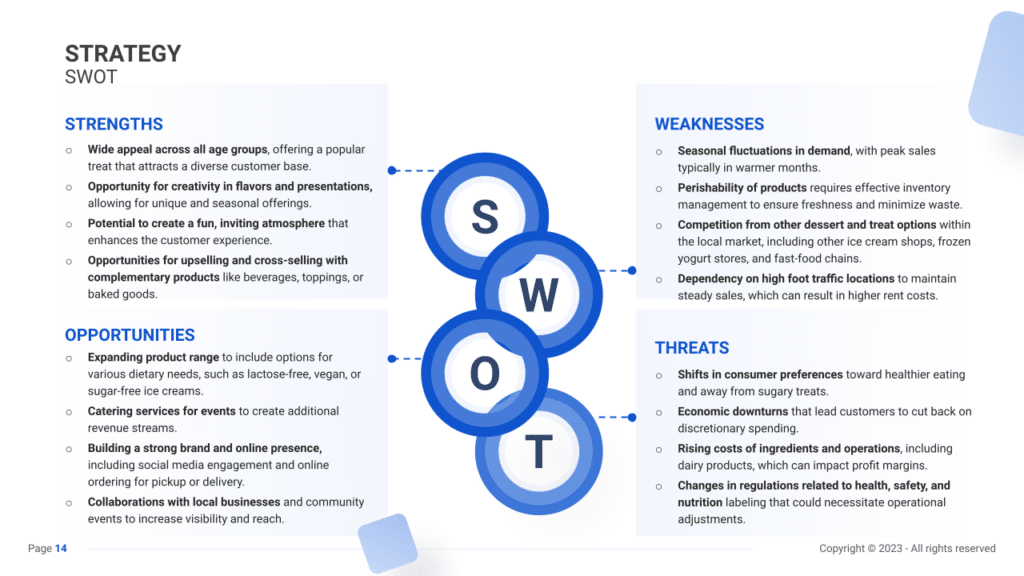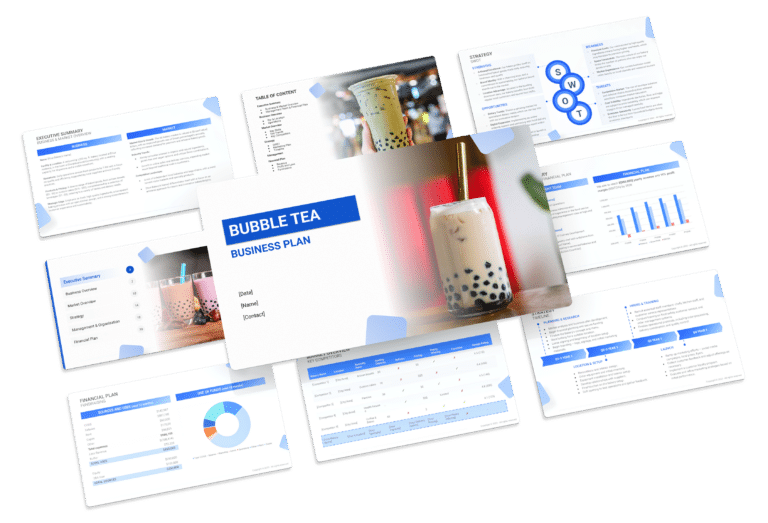How to Prepare a SWOT for an Ice Cream Shop

A cornerstone in crafting a business plan for an ice cream shop is the essential SWOT analysis. SWOT, which stands for Strengths, Weaknesses, Opportunities, and Threats, presents a comprehensive framework for owners to assess their business from both internal and external perspectives.
By conducting a SWOT analysis, ice cream shop owners gain a clear understanding of their position in the current market. It serves as a strategic tool to pinpoint areas for potential growth and improvement. For instance, strengths may include a diverse array of flavors, while weaknesses might involve constraints like limited seating.
In the upcoming discussion, we will explore various examples of strengths and weaknesses, providing ice cream shop owners with valuable insights on how to effectively integrate them into their business plans.

Strengths
- Unique Flavor Combinations: Ice cream is a versatile treat, allowing for endless flavor possibilities.
- Example: Offering innovative and exclusive flavor combinations like lavender-honey or avocado-lime can set your ice cream shop studio apart from competitors and attract adventurous food enthusiasts.
- Quality Ingredients: Using high-quality ingredients can enhance the taste and reputation of your ice cream.
- Example: Sourcing local, organic dairy and fresh fruits can emphasize your commitment to quality, attracting health-conscious customers.
- Customization Options: Allowing customers to customize their ice cream creations fosters a sense of ownership.
- Example: Implementing a “create your own sundae” station with a wide variety of toppings and sauces can lead to increased customer satisfaction and loyalty.
- Charming Ambiance: A cozy and inviting atmosphere can enhance the overall ice cream experience.
- Example: Incorporating nostalgic decor elements and comfortable seating arrangements can encourage customers to linger, boosting sales and customer satisfaction.
Weaknesses
- Seasonal Demand: Ice cream consumption tends to vary with the seasons, leading to seasonal fluctuations in revenue.
- Example: Developing a strategy to promote ice cream as a year-round treat by introducing hot desserts in the colder months can help mitigate this weakness.
- Limited Health-Conscious Options: Some customers may be hesitant to indulge in traditional ice cream due to health concerns.
- Example: Expanding your menu to include low-fat, sugar-free, or dairy-free options can attract a broader customer base, including those with dietary restrictions.
- High Operating Costs: Maintaining and running ice cream production equipment can be costly.
- Example: Exploring cost-saving initiatives such as energy-efficient appliances or joint purchasing agreements with suppliers can help manage operational expenses.
- Competition: The ice cream industry is highly competitive, with many established and emerging brands.
- Example: Implementing unique marketing strategies, like hosting ice cream-themed events or collaborating with local influencers, can help your ice cream shop studio stand out.
Opportunities
- Collaborations and Partnerships: Partnering with other local businesses can expand your customer base and generate mutual promotion opportunities.
- Example: Collaborating with a nearby bakery to create ice cream sandwiches or milkshake specials can attract customers from both establishments.
- Online Ordering and Delivery: The trend of online food delivery continues to grow, offering an opportunity to tap into a broader market.
- Example: Establishing an online ordering platform and partnering with popular delivery services can make your ice cream accessible to a wider audience.
- Seasonal Promotions: Capitalizing on holidays and seasonal events can boost sales during peak periods.
- Example: Creating limited-time holiday-themed flavors or offering discounts during summer festivals can drive foot traffic to your shop.
- Customer Loyalty Programs: Rewarding repeat customers can encourage them to return and recommend your ice cream shop to others.
- Example: Implementing a loyalty program with discounts, free toppings, or exclusive flavor releases can foster customer loyalty and increase repeat business.
Threats
- Health and Dietary Trends: Shifting consumer preferences towards healthier options may impact traditional ice cream sales.
- Example: Continuously researching and offering health-conscious alternatives can help mitigate the threat posed by changing dietary trends.
- Supply Chain Disruptions: External factors such as weather or global events can disrupt the supply chain, affecting ingredient availability.
- Example: Maintaining backup suppliers and regularly monitoring the supply chain can help minimize disruptions and ensure a consistent product offering.
- Economic Downturns: Economic recessions or downturns can lead to decreased consumer spending on discretionary items like ice cream.
- Example: Developing cost-effective menu options and offering value deals during challenging economic times can help retain customers.
- Regulatory Changes: Evolving regulations regarding food safety, labeling, or health standards can require adjustments to your operations.
- Example: Staying informed about and adhering to regulatory changes ensures compliance and prevents potential legal issues.





